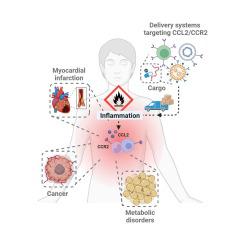当前位置:
X-MOL 学术
›
Adv. Drug Deliver. Rev.
›
论文详情
Our official English website, www.x-mol.net, welcomes your
feedback! (Note: you will need to create a separate account there.)
The role of CCL2/CCR2 axis in cancer and inflammation: The next frontier in nanomedicine
Advanced Drug Delivery Reviews ( IF 15.2 ) Pub Date : 2024-04-21 , DOI: 10.1016/j.addr.2024.115318 Sabina Pozzi 1 , Ronit Satchi-Fainaro 2
Advanced Drug Delivery Reviews ( IF 15.2 ) Pub Date : 2024-04-21 , DOI: 10.1016/j.addr.2024.115318 Sabina Pozzi 1 , Ronit Satchi-Fainaro 2
Affiliation

|
The communication between cells and their microenvironment represents an intrinsic and essential attribute that takes place in several biological processes, including tissue homeostasis and tissue repair. Among these interactions, inflammation is certainly a central biological response that occurs through cytokines and the crosstalk with their respective receptors. In particular, the interaction between CCL2 and its main receptor, CCR2, plays a pivotal role in both harmful and protective inflammatory states, including cancer-mediated inflammation. The activation of the CCL2/CCR2 axis was shown to dictate the migration of macrophages with immune-suppressive phenotype and to aggravate the progression of different cancer types. In addition, this interaction mediates metastasis formation, further limiting the potential therapeutic outcome of anti-cancer drugs. Attempts to inhibit pharmacologically the CCL2/CCR2 axis have yet to show its anti-cancer efficacy as a single agent, but it sheds light on its role as a powerful tool to selectively alleviate pro-tumorigenic and anti-repair inflammation. In this review, we will elucidate the role of CCL2/CCR2 axis in promoting cancer inflammation by activating the host pro-tumorigenic phenotype. Moreover, we will provide some insight into the potential therapeutic benefit of targeting the CCL2/CCR2 axis for cancer and inflammation using novel delivery systems, aiming to sensitize non-responders to currently approved immunotherapies and offer new combinatory approaches.
中文翻译:

CCL2/CCR2 轴在癌症和炎症中的作用:纳米医学的下一个前沿
细胞与其微环境之间的通讯代表了在多种生物过程中发生的内在和基本属性,包括组织稳态和组织修复。在这些相互作用中,炎症无疑是通过细胞因子及其各自受体的串扰发生的核心生物反应。特别是,CCL2 与其主要受体 CCR2 之间的相互作用在有害和保护性炎症状态(包括癌症介导的炎症)中发挥着关键作用。研究表明,CCL2/CCR2 轴的激活可决定具有免疫抑制表型的巨噬细胞的迁移,并加剧不同癌症类型的进展。此外,这种相互作用介导转移形成,进一步限制了抗癌药物的潜在治疗效果。从药理上抑制 CCL2/CCR2 轴的尝试尚未显示其作为单一药物的抗癌功效,但它揭示了其作为选择性减轻促肿瘤和抗修复炎症的强大工具的作用。在这篇综述中,我们将阐明 CCL2/CCR2 轴通过激活宿主促肿瘤表型在促进癌症炎症中的作用。此外,我们将深入了解使用新型递送系统靶向 CCL2/CCR2 轴治疗癌症和炎症的潜在治疗益处,旨在提高无反应者对目前批准的免疫疗法的敏感性,并提供新的组合方法。
更新日期:2024-04-21
中文翻译:

CCL2/CCR2 轴在癌症和炎症中的作用:纳米医学的下一个前沿
细胞与其微环境之间的通讯代表了在多种生物过程中发生的内在和基本属性,包括组织稳态和组织修复。在这些相互作用中,炎症无疑是通过细胞因子及其各自受体的串扰发生的核心生物反应。特别是,CCL2 与其主要受体 CCR2 之间的相互作用在有害和保护性炎症状态(包括癌症介导的炎症)中发挥着关键作用。研究表明,CCL2/CCR2 轴的激活可决定具有免疫抑制表型的巨噬细胞的迁移,并加剧不同癌症类型的进展。此外,这种相互作用介导转移形成,进一步限制了抗癌药物的潜在治疗效果。从药理上抑制 CCL2/CCR2 轴的尝试尚未显示其作为单一药物的抗癌功效,但它揭示了其作为选择性减轻促肿瘤和抗修复炎症的强大工具的作用。在这篇综述中,我们将阐明 CCL2/CCR2 轴通过激活宿主促肿瘤表型在促进癌症炎症中的作用。此外,我们将深入了解使用新型递送系统靶向 CCL2/CCR2 轴治疗癌症和炎症的潜在治疗益处,旨在提高无反应者对目前批准的免疫疗法的敏感性,并提供新的组合方法。































 京公网安备 11010802027423号
京公网安备 11010802027423号